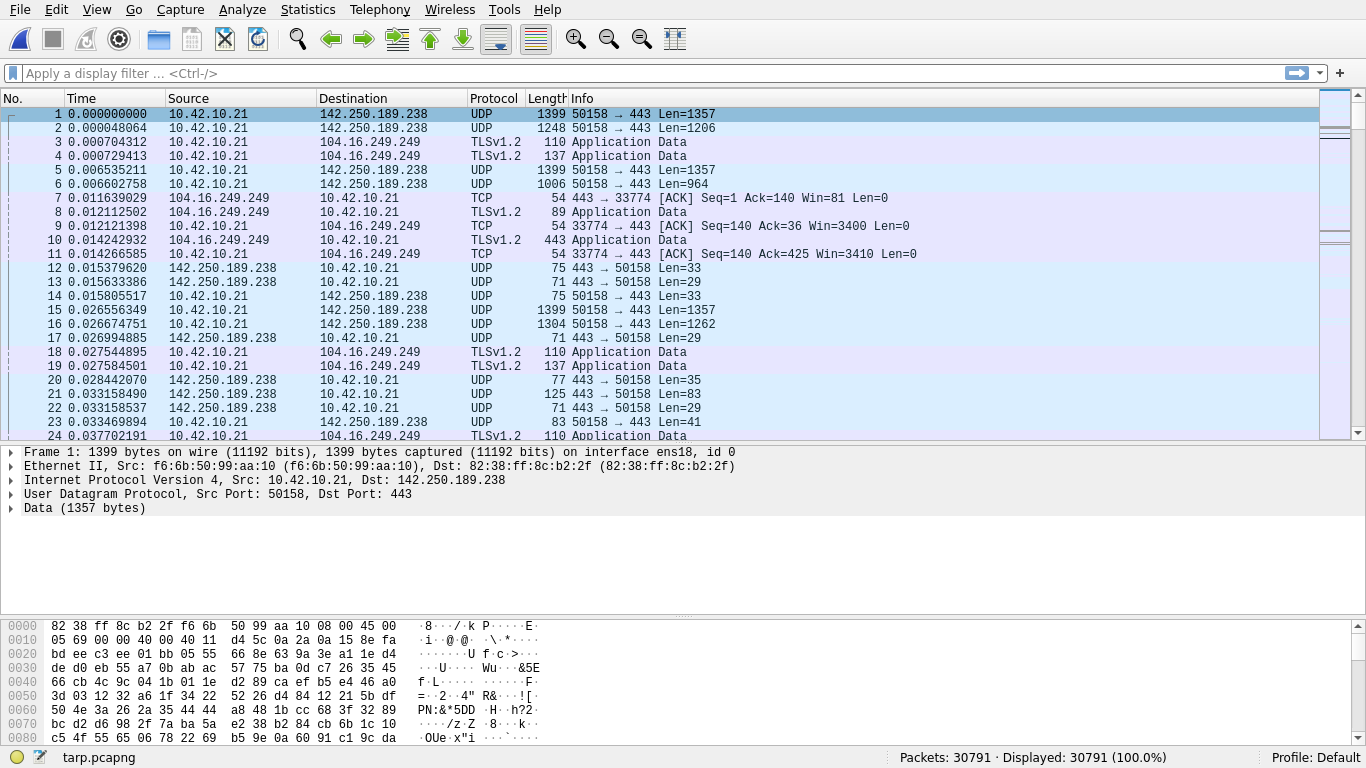Extracting Data Hidden in ARP Frames
Categories: forensics
2022-07-25
by skat
This writeup is also readable on my GitHub repository and personal website.
This is one of my three writeups from ImaginaryCTF. This particular challenge deals with data being discreetly embedded in link layer (layer 2) ARP frames in a given pcapng file, and my solution involved extracting all relevant ARP frames with Python and reassembling the data.
forensics/tARP
Challenge written by Eth007.
It helps to have a rain tarp when there’s bad weather.
Files: tarp.pcapng
Checksum (SHA-1):
3cb62d7136be8ca3ad2838c2fd2e1358dc570c63 tarp.pcapng
To start, we can begin with a cursory analysis of the given pcapng file:

There are 30791 frames in the pcapng with the bulk of them being QUIC (Quick UDP Internet Connections) and ARP (Address Resolution Protocol). 22137 (71.89%) of these contain IPv4 data, 20456 (92.41%) of which are UDP and the remainder being TCP.
Scrolling through the pcapng, something interesting becomes apparent amid a sudden rapid torrent of ARP frames:

The frame destinations being 00:00:00:00:00:00 may look strange at first, but this is actually rather standard for ARP and is an acceptable broadcast address in addition to the also common FF:FF:FF:FF:FF:FF, depending on the specific implementation; this is not abnormal. What is abnormal, however, are (1) the seeming randomness of the target IPs that F6:6B:50:99:AA:10 are trying to resolve, (2) the speed at which the frames are being transmitted, and (3) the lack of responses to these ARP requests.
A closer inspection of some of these frames reveals what appears to be plaintext data:

The target IP address of this ARP request, 2F 75 73 72, translates to /usr in ASCII. Indeed, scrolling through these frames makes it clear that some sort of data is being transmitted, hidden in the target IPs of ARP requests originating from this host:

Curious to explore this, an attack plan is devised: read all broadcasted ARP frames originating from F6:6B:50:99:AA:10 and write the last 4 bytes of each frame (the target IP) to a buffer, and finally write the buffer to a file for further analysis. My tool of choice for quick scripting like this is, as usual, Python:
#!/usr/bin/env python3
from scapy.all import *
def main():
frames = rdpcap("./tarp.pcapng")
arp = [f for f in frames if ARP in f and
f.src == "f6:6b:50:99:aa:10" and f.dst == "00:00:00:00:00:00"]
data = b""
for f in arp:
data += bytes(f.payload)[-4:]
with open("./output.bin", "wb") as f:
f.write(data)
print("Data written to ./output.bin")
if __name__ == "__main__":
main()
Running this script and then carving the resultant file, sure enough, finds a PNG:

This PNG, however, cannot be viewed quite yet due to a CRC error in the IEND chunk. I can already tell from experience that this is usually due to some extra data in the IEND chunk, probably from some subsequent frames unrelated to the PNG:

Viewing the PNG’s IEND chunk under a hex editor, we can see that there are indeed 4 extra bytes following the true end of the PNG. Removal of these bytes result in the computed CRC matching the expected CRC, and the PNG can now be viewed normally:


This was a very cool challenge and it’s definitely not unheard of in the real world to hide data in other protocols! I love seeing networking anywhere in CTFs, so this challenge was a lot of fun to do. By analyzing a pcapng and noticing an irregularity in ARP frames, we quickly extracted, analyzed, and viewed data discreetly embedded in a link layer (layer 2) protocol.
Happy hacking!